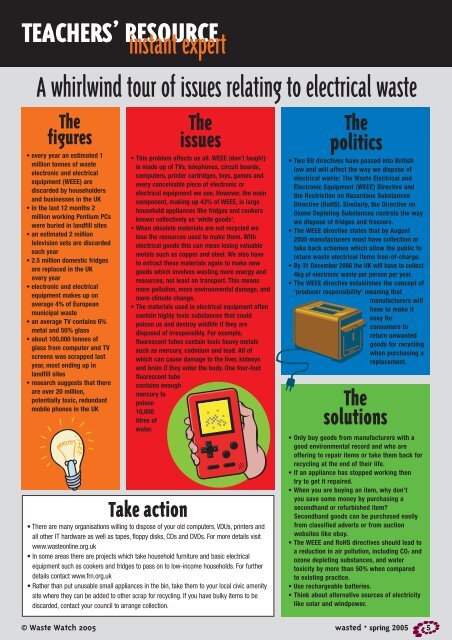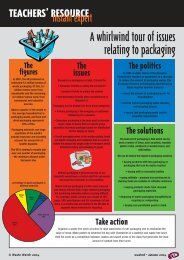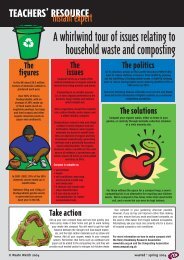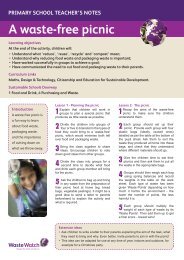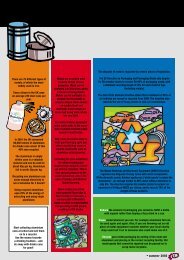Print 3889 WASTED NEWSLETTER 7 - Recyclezone
Print 3889 WASTED NEWSLETTER 7 - Recyclezone
Print 3889 WASTED NEWSLETTER 7 - Recyclezone
You also want an ePaper? Increase the reach of your titles
YUMPU automatically turns print PDFs into web optimized ePapers that Google loves.
TEACHERS’ RESOURCE<br />
instant expert<br />
A whirlwind tour of issues relating to electrical waste<br />
The<br />
figures<br />
• every year an estimated 1<br />
million tonnes of waste<br />
electronic and electrical<br />
equipment (WEEE) are<br />
discarded by householders<br />
and businesses in the UK<br />
• in the last 12 months 2<br />
million working Pentium PCs<br />
were buried in landfill sites<br />
• an estimated 2 million<br />
television sets are discarded<br />
each year<br />
• 2.5 million domestic fridges<br />
are replaced in the UK<br />
every year<br />
• electronic and electrical<br />
equipment makes up on<br />
average 4% of European<br />
municipal waste<br />
• an average TV contains 6%<br />
metal and 50% glass<br />
• about 100,000 tonnes of<br />
glass from computer and TV<br />
screens was scrapped last<br />
year, most ending up in<br />
landfill sites<br />
• research suggests that there<br />
are over 20 million,<br />
potentially toxic, redundant<br />
mobile phones in the UK<br />
The<br />
issues<br />
• This problem affects us all. WEEE (don’t laugh!)<br />
is made up of TVs, telephones, circuit boards,<br />
computers, printer cartridges, toys, games and<br />
every conceivable piece of electronic or<br />
electrical equipment we use. However, the main<br />
component, making up 43% of WEEE, is large<br />
household appliances like fridges and cookers<br />
known collectively as ‘white goods’.<br />
• When obsolete materials are not recycled we<br />
lose the resources used to make them. With<br />
electrical goods this can mean losing valuable<br />
metals such as copper and steel. We also have<br />
to extract these materials again to make new<br />
goods which involves wasting more energy and<br />
resources, not least on transport. This means<br />
more pollution, more environmental damage, and<br />
more climate change.<br />
• The materials used in electrical equipment often<br />
contain highly toxic substances that could<br />
poison us and destroy wildlife if they are<br />
disposed of irresponsibly. For example,<br />
fluorescent tubes contain toxic heavy metals<br />
such as mercury, cadmium and lead. All of<br />
which can cause damage to the liver, kidneys<br />
and brain if they enter the body. One four-foot<br />
fluorescent tube<br />
contains enough<br />
mercury to<br />
poison<br />
10,000<br />
litres of<br />
water.<br />
Take action<br />
• There are many organisations willing to dispose of your old computers, VDUs, printers and<br />
all other IT hardware as well as tapes, floppy disks, CDs and DVDs. For more details visit<br />
www.wasteonline.org.uk<br />
• In some areas there are projects which take household furniture and basic electrical<br />
equipment such as cookers and fridges to pass on to low-income households. For further<br />
details contact www.frn.org.uk<br />
• Rather than put unusable small appliances in the bin, take them to your local civic amenity<br />
site where they can be added to other scrap for recycling. If you have bulky items to be<br />
discarded, contact your council to arrange collection.<br />
The<br />
politics<br />
• Two EU directives have passed into British<br />
law and will affect the way we dispose of<br />
electrical waste: The Waste Electrical and<br />
Electronic Equipment (WEEE) Directive and<br />
the Restriction on Hazardous Substances<br />
Directive (RoHS). Similarly, the Directive on<br />
Ozone Depleting Substances controls the way<br />
we dispose of fridges and freezers.<br />
• The WEEE directive states that by August<br />
2005 manufacturers must have collection or<br />
take back schemes which allow the public to<br />
return waste electrical items free-of-charge.<br />
• By 31 December 2006 the UK will have to collect<br />
4kg of electronic waste per person per year.<br />
• The WEEE directive establishes the concept of<br />
‘producer responsibility’ meaning that<br />
manufacturers will<br />
have to make it<br />
easy for<br />
consumers to<br />
return unwanted<br />
goods for recycling<br />
when purchasing a<br />
replacement.<br />
The<br />
solutions<br />
• Only buy goods from manufacturers with a<br />
good environmental record and who are<br />
offering to repair items or take them back for<br />
recycling at the end of their life.<br />
• If an appliance has stopped working then<br />
try to get it repaired.<br />
• When you are buying an item, why don’t<br />
you save some money by purchasing a<br />
secondhand or refurbished item?<br />
Secondhand goods can be purchased easily<br />
from classified adverts or from auction<br />
websites like ebay.<br />
• The WEEE and RoHS directives should lead to<br />
a reduction in air pollution, including CO2 and<br />
ozone depleting substances, and water<br />
toxicity by more than 50% when compared<br />
to existing practice.<br />
• Use rechargeable batteries.<br />
• Think about alternative sources of electricity<br />
like solar and windpower.<br />
© Waste Watch 2005<br />
wasted • spring 2005 5
TEACHERS’ RESOURCE<br />
primary years<br />
Make your own battery<br />
Batteries are a useful way of storing electricity so that electricity is available<br />
to us wherever we go. Batteries come in many shapes and sizes,<br />
depending on how we want to use them. For example, a watch battery<br />
needs to be small and light enough to fit inside a wrist watch. But whatever<br />
the size and shape of a battery, they all work in the same way.<br />
How batteries work<br />
The scientific name for a battery is a cell. They contain<br />
chemicals in the form of a paste which is<br />
wrapped up in metal. When the chemicals mix<br />
together they make electricity which flows as a current<br />
from the negative (-) end to the positive (+) end<br />
to power your toys, torches and mobile phones.<br />
You should never try to open a battery because the chemicals and metals<br />
inside are poisonous. When batteries get thrown away into landfill sites<br />
the chemicals eventually leak out and can poison rivers, plants and animals.<br />
But you can make a battery without dangerous chemicals.<br />
The first battery<br />
The first battery was made 300 years<br />
ago by an Italian called Allessandro<br />
Volta. He piled copper and silver<br />
coins on top of each other with a<br />
layer of cardboard soaked in salty<br />
water in between. To make the current<br />
flow he needed to complete the<br />
circuit using a piece of copper wire<br />
to join the bottom of the pile to the<br />
top. The current moves from the negative<br />
end to the positive end just like in modern batteries. He called it<br />
a Voltaic cell.<br />
Try making one yourself using 2p and 10p coins. There should be a<br />
different coin at the top and bottom of the pile (as in the diagram) with<br />
as many layers in between as you like. The bigger the battery the more<br />
electricity it makes. But there are problems with the Voltaic cell because<br />
the soggy cardboard dries up quickly and the battery goes flat.<br />
Robot recharge<br />
Did you know that Cycler the rapping robot<br />
is powered by wind?<br />
silver coin<br />
copper coin<br />
Following a busy day visiting schools<br />
around the country, Cycler the rapping<br />
robot is plugged into the mains<br />
socket to recharge his batteries. Waste<br />
Watch’s electricity supplier generates<br />
electricity from renewable sources like<br />
wind power. Do you use rechargeable<br />
batteries like Cycler? Where does your<br />
electricity come from?<br />
paper soaked in<br />
salty water<br />
+<br />
-<br />
Using a voltmeter we measured our lemon generating a whopping four volts<br />
Fruit battery<br />
There are many amazing things you can use to make a battery, even a<br />
piece of fruit!<br />
You will need<br />
citrus fruit<br />
piece of copper (eg a copper coin) about 5cm long<br />
piece of zinc (an ordinary galvanised screw) about 5cm long<br />
LED light or voltmeter with leads<br />
What to do<br />
1. Roll the fruit under the palm of your hand to soften the fruit, but be<br />
careful you don’t break the skin.<br />
2. Push the copper and zinc into the fruit about 5cm apart. Don’t allow<br />
the metal to go all the way through the fruit.<br />
3. Attach one end of the lead to the copper with a clip, and the other end<br />
to the zinc.<br />
4. If the circuit is complete, the LED should light up.<br />
What happens?<br />
The juice in the lemon contains acids that act in the same way as the<br />
chemicals in a regular battery.<br />
You can make the battery more powerful by joining several fruit batteries<br />
together with leads, just in the same way that torches sometimes<br />
use several batteries together to increase the flow of current. You can<br />
measure the amount of electrical current you make using a voltmeter.<br />
Try different fruit and vegetables to find out which fruit make the<br />
most electricity.<br />
Do not eat the fruit when you have finished. Put it in your<br />
compost bin.<br />
The activities on this page link to national curriculum areas such as science for key stage 1 & 2, unit 2F using electricity.<br />
6 spring 2005 • wasted © Waste Watch 2005
TEACHERS’ RESOURCE<br />
secondary years<br />
Eco-design for Chirpy Computers Ltd<br />
Chirpy Computers Ltd makes personal computers for home use. The company’s<br />
management have asked you to research a radical new product<br />
called the Chirp-e 3000. It will be the most environmentally friendly<br />
computer available.<br />
Working in groups, investigate<br />
alternative ways of producing your<br />
computer, addressing each of the<br />
areas detailed below so that the new<br />
computer is as ‘green’ as possible.<br />
Other sources of information you<br />
may wish to consult are computer company catalogues and websites, and<br />
environmental information such as www.wasteonline.org.uk<br />
Planned obsolescence<br />
Planned obsolescence is when a product is designed not to last for a long<br />
time. The reasoning is that it will then need to be replaced, creating<br />
demand for new products, and more profits for the manufacturer.<br />
Unfortunately, until now Chirpy Computers have been producing computers<br />
with planned obsolescence by<br />
• installing software on their computers that is difficult to upgrade<br />
• not offering spare parts or service options that enable old computers<br />
to be repaired<br />
• using hardware that is difficult to upgrade with the latest components<br />
What’s the problem? Planned obsolescence uses up natural resources<br />
and causes waste.<br />
As computers are upgraded can you find ways of ensuring the old hardware<br />
doesn’t just get thrown away?<br />
Find a solution. In what ways can you make sure that the Chirp-e 3000<br />
computer avoids becoming obsolete?<br />
Packaging & shipping<br />
Packaging is important to protect the product during transportation. Until<br />
now Chirpy Computers Ltd have been packaging their computers in polythene<br />
bags surrounded by polystyrene, all of which comes in a box made<br />
from a layer of cardboard glued to a layer of plastic. Cables, discs and manuals<br />
come separately packed inside polythene and foil bags. This is then<br />
shipped from factories in the Far East to the UK.<br />
What’s the problem? The packaging materials currently being used cannot<br />
be reused, easily separated, or recycled, and the packaging is not<br />
made from recycled material. Furthermore, the boxes are made from a<br />
layer of plastic glued to card. Multi-material packaging such as this is very<br />
difficult to separate into its component parts for recycling. On top of this,<br />
very few people have access to a polystyrene recycling facility.<br />
Find a solution. If your new computer is going to be the most<br />
environmentally friendly computer available you will need to find less<br />
wasteful ways of packaging and shipping your product.<br />
• Find out which packaging materials can be easily recycled and how<br />
they should be labelled.<br />
• Look at packaging design and consider multi packs rather than<br />
individually wrapped. Can the packaging be reused?<br />
• Are all the freebies and software available with computers really<br />
necessary?<br />
• Investigate where the products are made, is it possible for them to be<br />
manufactured closer to the UK and therefore decrease the environmental<br />
impact of transportation?<br />
Toxic materials<br />
The manufacturing of computer’s and their component parts typically<br />
involves many hazardous substances, including<br />
• lead and cadmium in computer circuit boards<br />
• lead oxide and barium in computer monitors’ cathode ray tubes<br />
• mercury in switches and flat screens<br />
• brominated flame retardants on printed circuit boards, cables and<br />
plastic casing<br />
What’s the problem? Many of the chemicals used in computers are toxic.<br />
Furthermore, at the end of the computer’s life the components are difficult<br />
to dismantle and dispose of.<br />
Find a solution. If Chirpy Computers Ltd is going to be more environmentally<br />
friendly than its competitors then it will need to come up with ways to<br />
lessen the impact of the toxic chemicals used to make its computers.<br />
• Investigate options for removable, rechargeable and recyclable<br />
batteries. Are companies publicising these options?<br />
• Who has responsibility for disposing of the computer safely at the end<br />
of its life, the company or the consumer? Find out more about take<br />
back schemes.<br />
• How can components be designed or labelled to allow them to be<br />
recycled more easily?<br />
Other design and manufacturing factors<br />
Consider other areas that Chirpy Computer Ltd. will need to address<br />
Find a solution<br />
• What materials should be used to manufacture the computer? Could<br />
metal casing be used rather than plastic? Which is more environmentally<br />
friendly?<br />
• Is it possible to use any other recycled materials in manufacture?<br />
• How could the factory use less water, paper and electricity?<br />
Now, give a presentation on your ideas for the new,<br />
environmentally friendly, Chirp-e 3000 computer.<br />
This activity could be used in a design and technology class incorporating ICT.<br />
© Waste Watch 2005<br />
wasted • spring 2005 7
TEACHERS’ RESOURCE world view<br />
Focus on mobile phones<br />
The mobile phone is one of the technological innovations of our generation.<br />
But alongside the obvious benefits the mobile phone brings us, there are<br />
also costs. Follow us on a trip around the world to look at some of the effects<br />
of the production of mobile phones.<br />
It is estimated that about 45 million people use a mobile phone in the UK,<br />
around 75% of the population. World wide there are 1.25 billion mobile<br />
phone users and this number is steadily rising. As new phones come onto<br />
the market, or as old phones are broken, people replace their mobiles.<br />
However, at the moment these old phones are seldom recycled. For example,<br />
in Europe 58 million replacement mobiles are bought each year, with<br />
approximately 85 million unused phones lying around in people’s homes.<br />
Millions of these old phones could be recycled, although it is estimated that<br />
fewer than 5% are.<br />
industry has a history of oil spills in the area. Activists estimate that in the<br />
last 30 years more oil has been leaked into the ground in Ecuador than was<br />
spilt by the oil tanker Exxon Valdez which was<br />
wrecked off the coast of Alaska in 1989.<br />
Metals and minerals<br />
In addition to plastic the mobile also contains a<br />
number of different metals, some of which are<br />
among the most dangerous known to man including<br />
cadmium, rhodium, palladium, beryllium and<br />
lead. These metals need to be disposed of safely.<br />
Democratic Republic of Congo<br />
One key component of mobile phones is a capacitor which contains the mineral<br />
coltan. The largest deposits of coltan are found in Australia and the<br />
Democratic Republic of Congo (DRC). The DRC is currently ravaged by a<br />
three year civil war which has cost over 10,000 lives and displaced a further<br />
200,000 people. The United Nations, Human Rights Watch and the<br />
World Conservation Union say fighters are selling coltan to help fund the<br />
war. On top of the human suffering wildlife is also at risk. Endangered<br />
species in the area such as the gorilla, are beyond protection and are being<br />
hunted for food.<br />
To comply with the Waste Electrical and Electronic Equipment (WEEE) directive,<br />
mobile phone manufacturers will have to ensure that all mobile phones<br />
are recycled by August 2005.<br />
The mobile phone is made up of valuable materials from all over the world.<br />
If we don’t recycle our phones then these materials are lost, and the costly<br />
process of extracting and refining new materials must continue over and<br />
over again.<br />
Plastics<br />
A mobile phone is largely made from plastic, which in turn is made from oil.<br />
So to start our journey we could go to any oil producing country such as<br />
Saudi Arabia, Russia, Angola, Ecuador, USA or Norway to name but a few.<br />
Let’s start in Ecuador.<br />
In the Ecuadorian rainforest the oil industry is working hard to produce as<br />
much oil as possible. This is not without environmental consequence. The oil<br />
Mexico<br />
After all the components have been brought together the phones are assembled<br />
in large mobile phone factories like the ones found in Mexico. The charity<br />
Save the Children dispute the working conditions for mobile phone factory<br />
workers in Mexico saying that companies are taking advantage of suspended<br />
labour laws designed to attract foreign investment. It claims that<br />
workers are paid poorly and forced to<br />
put up with bad working conditions.<br />
Discuss these issues with your class.<br />
Can you think of any ways to make<br />
mobile phones more sustainable? What<br />
should you do with old mobile phones?<br />
Sources<br />
www.mobiletakeback.co.uk<br />
Eurosource Europe, Nov 2004<br />
BBC News; www.bbc.co.uk/nature/animals/features/186index.shtml<br />
This resource can dovetail into any geography and citizenship classes.<br />
8 spring 2005 • wasted © Waste Watch 2005
TEACHERS’ useful RESOURCE resources<br />
All the information you need is out there on the<br />
internet – somewhere! We tell you where to look.<br />
Waste Online<br />
This website should be top of<br />
your list to visit if you need information<br />
on any aspect of waste or<br />
recycling. There are terrific factsheets<br />
that tell you everything you<br />
need to know on a wide variety of<br />
topics. The information on electronic<br />
and electrical waste is<br />
particularly good.<br />
www.wasteonline.org.uk<br />
Reuze<br />
Reuze is a great source of information<br />
and contacts across the<br />
recycling sector. It provides information<br />
on recycling, lists of organisations<br />
providing recycling services,<br />
and a selection of products<br />
made from recycled materials. The<br />
materials and products listed<br />
include toners, batteries and CDs.<br />
There is also a set of information<br />
posters that you can download,<br />
providing information on where<br />
you can recycle items like mobile<br />
phones, sunglasses and paint.<br />
www.reuze.co.uk<br />
Envocare<br />
This site covers topics about the<br />
natural environment, recycling and<br />
hazardous waste as well as energy<br />
and human resources, composting<br />
and environmental issues. There is<br />
comprehensive information on the<br />
recycling of electrical goods,<br />
including mobile phones and<br />
fridges, and there are good links to<br />
recycling companies. There is even<br />
a section where you can send<br />
electronic greetings cards to your<br />
friends, and lots of great pictures<br />
to use as computer wallpaper.<br />
www.envocare.co.uk<br />
© Waste Watch 2005<br />
Sustainable Design<br />
Award<br />
The sustainable design award is a<br />
freely available scheme for teachers<br />
and students, intended to bring<br />
issues of sustainability into design<br />
and technology classes. There’s lots<br />
of information on the website to<br />
inspire the designers of tomorrow<br />
and ideas for conveying the wider<br />
issues of sustainability to kids.<br />
www.sda-uk.org<br />
Wesp Network<br />
Our Waste Education Support<br />
Programme is launching an online<br />
forum in Spring 2005.<br />
Watch this space!<br />
www.wastewatch.org.uk/education<br />
How Stuff Works<br />
This is another American site so<br />
be prepared for adverts and<br />
pop-ups. However, once you are<br />
past these there’s an impressive<br />
store of information explaining how<br />
things work, including electrical<br />
equipment such as batteries, DVD<br />
players, semi-conductors, electric<br />
motors, circuit breakers, computer<br />
hardware, GPS, and radar. Great<br />
background reading for budding<br />
designers, scientists and engineers.<br />
www.science.howstuffworks.com<br />
Recylezone<br />
Happy 1st birthday to <strong>Recyclezone</strong>!<br />
This Waste Watch website specially<br />
for children and teachers is now<br />
one year old, and is packed with<br />
games, quizzes and information on<br />
waste and how to cut it. Websites<br />
like <strong>Recyclezone</strong> show the power of<br />
the web to present information<br />
without the need for paper magazines<br />
and newsletters that need to<br />
be recycled after being read.<br />
www.recyclezone.org.uk<br />
Science Year<br />
This site, run by NESTA, is geared<br />
towards children and adults covering<br />
science activities that link in<br />
with the national curriculum.<br />
Activities include sound, cocoa<br />
craters, exploding volcanoes as well<br />
as electricity in the home, energy<br />
resources, flight etc. There are lots<br />
of fun science activities that will<br />
appeal to all ages. Science Year are<br />
currently developing activities for<br />
under 11s.<br />
www.scienceyear.com<br />
Green Consumer Guide<br />
This site gives up to date news on<br />
green consumer issues and the<br />
latest environmental news from the<br />
political arena. You can find information<br />
on energy efficient products<br />
including IT equipment, audio<br />
appliances, fridges and washing<br />
machines. They even have a link to<br />
a solar powered PA sound system<br />
for outdoor festivals (backup is provided<br />
by bicycle generators).<br />
www.greenconsumerguide.com<br />
It’s out there on the internet – Fridgehenge<br />
One worrying piece of environmental news over the last few years<br />
was the appearance of so-called ‘fridge mountains’ following tighter<br />
disposal regulations introduced to protect the ozone layer from harmful<br />
substances found in old fridges. However, it seems that several<br />
people around the world have been making their own fridge mountains<br />
in the name of art.<br />
The idea started in 1994 in Hamilton, New Zealand when three<br />
locals decided to celebrate the summer solstice by constructing a<br />
miniature version of Stonehenge from old fridges. ‘Fridgehenge’ was<br />
an instant crowd pleaser and the idea soon spread.<br />
A larger version of Fridgehenge was then constructed by US artist,<br />
anthropologist and filmmaker Adam Horowitz near Santa Fe as “a<br />
monument to consumerism and the hubris of man”. While the original<br />
Stonehenge is orientated towards the summer solstice sunrise, the US<br />
Fridgehenge is orientated towards the Los Alamos laboratory which<br />
the artist describes as the “atomic solstice”.<br />
Stonehenge has also inspired another monument made from scrap<br />
materials. Carhenge is made entirely from old automobiles with a<br />
Cadillac taking pride of place in the altar stone’s position.<br />
www.etete.com/torrie/Fridgehenge.html<br />
www.blueyonder.co.uk/blueyonder/getContent.jspx?page=642872&gr<br />
oup=tv_page<br />
www.worldofkitsch.com/features/seven_wonders/carhenge.html<br />
wasted • spring 2005 9
TEACHERS’ RESOURCES<br />
Dinosaur Robots from Junk<br />
The format<br />
This book gives easy to follow instructions on how to make five dinosaur robots from unwanted<br />
household junk. ‘T-Wrecks’, ‘Terror Saw’, ‘Cyber-Ceratops’, ‘Brontobot’ and ‘Ballistasaurus’ can be<br />
made from plastic bottles, coat hangers, old CDs, lids, clothes pegs, air fresheners and plastic bags<br />
as well as many other bits and pieces. The book has full lists of all parts and tools needed plus step<br />
by step instructions on how to assemble each robot. There<br />
are some good ‘top tips’ to help you along the way. Once the<br />
robots have been made there are ideas for decorating them<br />
and two pages of stickers are provided to choose from.<br />
The section entitled Battle Bank will be a favourite for fans of<br />
the BBC programmes Robot Wars and Techno Games. Here,<br />
ideas are given for pitching robots against each other to see<br />
which one emerges as the supreme ‘Dinobot Warrior’. We are<br />
also given details of four tough challenges to set each of your<br />
robots. You can make your own arena and keep scores on a<br />
special score sheet. For those who are confident in going further<br />
you can bring your dinobot to life with a motor, lights or<br />
buzzers, as well as making a remote control.<br />
Every issue we review an education<br />
resource that teachers can use in<br />
the classroom. Here we take a look<br />
at Making Dinosaurs from Junk by<br />
Stephen Munzer.<br />
This book contains some ambitious<br />
craft projects detailing how to build<br />
model dinosaurs from waste.<br />
Due to the advanced nature of some of the model making,<br />
adult help is essential for most of the projects detailed in the<br />
book. However, hazards are listed in each section and there is good safety advice.<br />
A basic glossary and some links to other robot websites are included at the end of the book.<br />
Dates<br />
for your<br />
diary<br />
1-13 March<br />
Fair Trade Week comes around once again with<br />
two weeks of events to promote fair trade products<br />
that pay a fair price to the producer. Be sure to<br />
hunt out the fair trade logo on products, and sleep<br />
with a clear conscience as a result. www.fairtrade.org.uk<br />
6 March<br />
Mother’s day is a our chance to make up for all<br />
the headaches we’ve given our parents over the<br />
years! What better way to do this than to send a<br />
card made from recycled materials? That way, we<br />
can show we care for mother earth too!<br />
22 March<br />
A national forum for waste educators is launched<br />
this morning at the Princess Diana memorial trust<br />
buildings in London. Attendees have been invited to<br />
schmooze with parliamentarians afterwards!<br />
www.wastewatch.org.uk/education.<br />
22 March<br />
Waste Watch education campaign briefing event at<br />
the House of Commons. This exclusive get together<br />
is our big chance to tell powerful people what a<br />
good job waste educators are doing for the environment<br />
www.wastewatch.org.uk/education.<br />
12 April<br />
The RSA unveil the WEEE man at Potter’s Fields<br />
near Tower Bridge in London. This impressive<br />
structure will be made from the electrical waste<br />
that one person can expect to use in a lifetime. It is<br />
hoped that the WEEE man will inspire the public,<br />
retailers and manufacturers to think twice about<br />
waste. The WEEE man will be on display for four<br />
weeks. www.rsa.org.uk<br />
18-19 May<br />
The Community Recycling Network is holding its<br />
annual conference in Coventry. This event is a great<br />
chance for grass roots organisations to get together<br />
and share ideas about cutting waste to the max!<br />
www.crn.org.uk<br />
The audience<br />
This is definitely a book for upper key stage 2. Technically the processes are quite difficult and<br />
require a lot of time and preparation. You would have to simplify the projects significantly for key<br />
stage 1 or lower key stage 2.<br />
Curriculum links<br />
The activities in the book have great potential for cross-curricular links. The process of sorting out<br />
junk to use for the robots will link in with QCA science unit 3A: characteristics of materials. Links to<br />
environmental work, art and design, and technology are also strong.<br />
Making Dinosaur Robots From Junk is published by Chicken House and is available to buy<br />
from www.thebookpeople.co.uk<br />
12 spring 2005 • wasted


